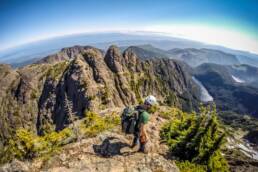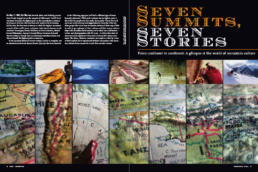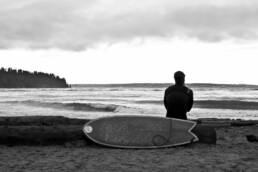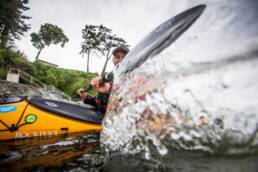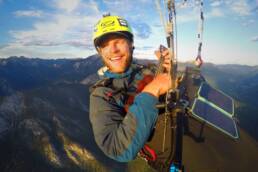Its sightlines span from Mt. Waddington to Mt. Baker. Multiple peaks and righteous rock provide alpinists with a rare island experience. Need a reason to visit Mt. Arrowsmith? Walk this way. By Chris Istace.
When you stand before the jagged skyline of Mt. Arrowsmith, it’s difficult to grasp how this impressive mountain on Vancouver Island, British Columbia, only became a protected regional park in 2008. The tallest peak of the southern island ranges, it is easily accessible from nearby Highway 4, between Qualicum and Port Alberni, and it is often the first alpine summit attempted by Van Isle climbers, much as it was for me years ago.
With the day’s soft glowing light illuminating the peak, I hike through the forest of cedar and fir on a cold morning for my annual climb up Arrowsmith, this time to celebrate the park’s 10th anniversary. As I traverse the Bumps, a section below the peak, I begin to see stunning views to the southeast, with the Salish Sea opening up below. Few alpine climbs offer views of the ocean the way Arrowsmith does. On particularly vivid, clear mornings, Mt. Baker can even be seen in distant Washington State.
“There are no big mountains on the island” is a common phrase among those who’ve never crossed the Salish Sea. It’s a misconception Van Islanders do not mind.
Arrowsmith’s park designation is all thanks to the hard work of Peter Rothermel, and appreciation for his efforts is pervasive in the small-but-burgeoning local alpinist community. Rothermel mounted a 12-year campaign—alongside other passionate islanders—to preserve this 1,300-hectare mountain playground.
Rothermel once told me the First Nations who called the west side of Arrowsmith home named it Kuth-Kah-Chulth, which translates to “that which has many pointed faces.” He says those from the east side called her the Sleeping Maiden. These names reflect two very different topographical sides of an iconic peak.
With a final grasp on a rocky outcropping, I pull myself to the level ground of the lower summit. I turn around to admire the view of the Bumps and the subsequent Nose route, which I just climbed and scrambled.
The massif, which features a jagged collection of peaks, was collectively named Mt. Arrowsmith in 1853 after English cartographers John and Aaron Arrowsmith. The first recorded ascent was by John Mahoun in July of 1887 with local Indigenous guide Qualicum Tom. The famous mountaineers Don and Phyllis Munday completed ascents in 1925. It was during these climbs that they first sighted Mt. Waddington, the highest peak in the Coast Range. Several of the Munday’s photos are in the BC Archives at the Royal BC Museum in Victoria, British Columbia.
Qualicum Tom’s first ascent—and the area’s long history as home to several First Nations—probably means locals regularly summited Arrowsmith prior to colonization. I followed in their footsteps to gaze down at the protected land, the Sleeping Maiden and her many pointed faces finally at rest.
Related Stories
Island in the Sky
Entombed by ice, lost souls and legendary allure, the Cascades’ greatest peak has defined the Pacific Northwest’s…
Surfing Vancouver
For Vancouver surfers, finding waves usually means a flight, a ferry or a dash south to Washington. But every so often…
Meet The Youngest Person to Solo Paddle Around Vancouver Island
Seventeen-year-old Finn Steiner has just completed a solo circumnavigation of Vancouver Island via kayak making him the…
Slocan Paraglider Flies From Vancouver to Calgary
Benjamin Jordan is the first paraglider to journey from Vancouver to Calgary, Pacific to prairie, over the mountains of…
Book of the mountains – Trailer
"The Book of Mountains 3D" - a new film about skiing from Action Brothers, now in 3D! The film stars Ivan Oleynik, Ivan…
Vancouver Island Doesn’t Have Ski Touring, Right? Wrong.
It was a trip that didn't happen. To a peak that you shan't know. This is the tentative, untapped and newly cooperative…


